A High-Pressure Surface Cleaner is an attachment or accessory designed to work with high-pressure washers, improving the efficiency and results of cleaning large, flat surfaces. These tools use a rotating nozzle system that distributes the high-pressure water more evenly, providing a uniform and streak-free clean across various surfaces like driveways, patios, sidewalks, parking lots, and even commercial buildings.
High-Pressure Surface Cleaner
Key Features:
Rotating Nozzles:
High-pressure surface cleaners are equipped with rotating nozzles that spin at high speeds, providing an even distribution of water pressure across a wide area. This action ensures that the surface is cleaned uniformly without streaks or lines.
The rotation helps to break up stubborn dirt, grime, moss, mold, and stains faster than using a traditional pressure washer nozzle, which focuses the water in a single direction.
Wide Cleaning Area:
The surface cleaner is typically much wider than a single pressure washer nozzle, allowing you to clean larger areas in less time. Some models can cover 12 to 20 inches of surface in a single pass, making them ideal for large driveways, patios, and commercial spaces.
By covering a larger surface area, these tools are highly effective in saving time and improving productivity, especially for cleaning tasks that would otherwise take much longer with a standard nozzle.
Cleaning Efficiency:
The rotating nozzles create a uniform water flow, ensuring even coverage, which reduces the likelihood of streaks or uneven cleaning marks. This feature makes surface cleaners highly effective for cleaning hard, flat surfaces such as concrete, asphalt, pavers, and even decks.
The consistent pressure from the rotating nozzles also helps to agitate dirt and debris, making it easier to clean and remove it from the surface.
Durable Construction:
High-pressure surface cleaners are built with durable materials such as stainless steel, heavy-duty plastics, and reinforced components to withstand the high-pressure water and repetitive use.
Many models feature protective skirts around the nozzle area to prevent water from splashing up and to control water flow during cleaning.
Built-in Brushes:
Many high-pressure surface cleaners include brushes around the edge of the cleaner that help scrub stubborn dirt or grime while cleaning. These brushes are particularly useful for more delicate surfaces or areas with ingrained dirt.
These built-in brushes work in tandem with the water pressure, agitating debris to ensure a deep, thorough clean.
Compatibility with Pressure Washers:
High-pressure surface cleaners are designed to be compatible with both gas-powered and electric pressure washers, although it is important to match the cleaner with a pressure washer that provides an appropriate PSI (typically 2,000 to 4,000 PSI).
Some surface cleaners have adjustable pressure settings, allowing them to work efficiently with lower or higher pressure washers depending on the application.
Ergonomic Design:
These tools are typically lightweight and come with ergonomic handles for easy use and control, especially for long periods of cleaning.
Many models feature wheels that make them easy to maneuver across large surfaces without straining the user.
Versatility:
High-pressure surface cleaners are suitable for a range of cleaning tasks, including removing dirt, grime, oil, moss, mold, and stains from hard surfaces.
They can be used for driveways, patios, sidewalks, parking lots, decks, and even garage floors. Some models can also be used to clean walls, roofs, and large industrial equipment.
Safety Features:
High-pressure surface cleaners are often equipped with safety features such as automatic pressure relief valves, which help prevent excessive pressure from building up in the system and protect the user from injury.
Some models include splash-proof skirts or shields that contain the water spray to prevent injury or damage to surrounding areas.
Why Choose a High-Pressure Surface Cleaner?
Time-Saving: These cleaners cover larger areas more quickly than standard pressure washer nozzles, making them perfect for large-scale cleaning tasks.
Even Results: The rotating nozzle system ensures even, streak-free cleaning, which is particularly important for visible surfaces like driveways, parking lots, and patios.
Deep Cleaning: The combination of high pressure and rotating nozzles provides a more thorough clean than traditional washing methods, making it easier to remove deep-set dirt and grime.
Ideal For:
Homeowners who need a fast and efficient way to clean large outdoor surfaces like driveways, patios, and walkways.
Commercial businesses that need to maintain large parking lots, sidewalks, or building exteriors.
Contractors or pressure washing services looking for a tool to handle heavy-duty cleaning tasks quickly and professionally.
Industrial applications requiring the cleaning of factory floors, loading docks, or other large flat surfaces.
Applications:
Driveways & Sidewalks: Clean oil stains, dirt, moss, and mildew from concrete, asphalt, and brick surfaces with ease.
Patios & Decks: Remove dirt, debris, and stains from stone, wood, or composite decking and outdoor surfaces.
Parking Lots: Clean large parking lots or other commercial surfaces quickly without damaging the pavement.
Building Exteriors: Use to wash exterior walls or facades, removing dirt and grime from brick, stucco, or siding.
Industrial Surfaces: Clean factory floors, warehouses, and machinery in a time-efficient manner.
Tips for Use:
Use the Correct Pressure: Ensure your pressure washer and surface cleaner are compatible in terms of PSI. Too high a PSI could damage the surface, while too low may not be effective.
Keep the Cleaner Moving: Move the surface cleaner steadily across the surface to avoid streaking or leaving uneven cleaning marks.
Watch for Obstacles: Keep an eye out for objects or debris that might obstruct the cleaner’s movement or interfere with the cleaning process.
Maintenance Tips:
Clean the Nozzles Regularly: After each use, inspect and clean the nozzles and rotating parts to prevent clogging and ensure optimal performance.
Inspect for Wear: Check for any signs of wear or damage to the brushes or other parts of the surface cleaner, replacing them as necessary.
Store Properly: Store the surface cleaner in a dry, cool place to protect it from rust or other damage.
Rinse After Use: Always rinse the surface cleaner after each use to remove dirt and debris from the nozzle and internal components.

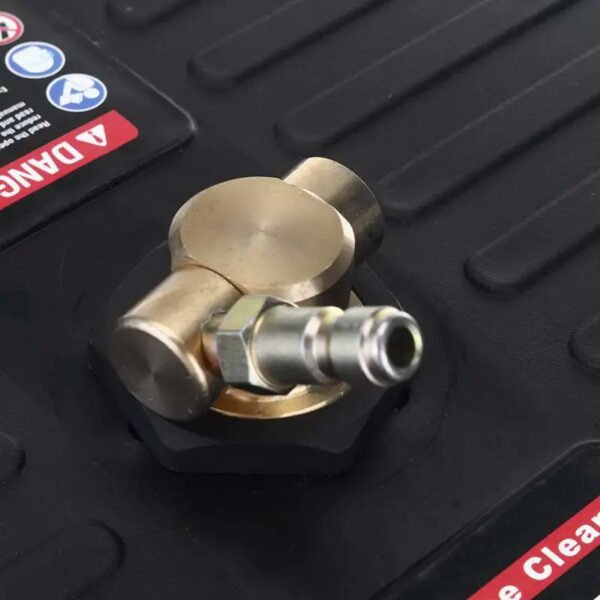
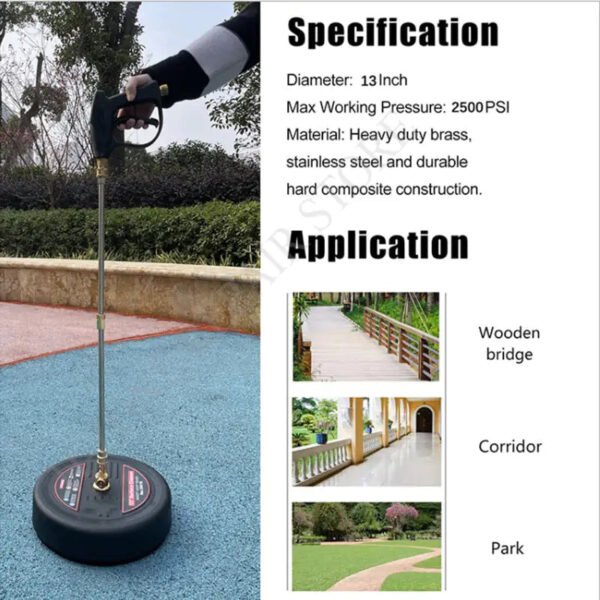
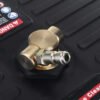
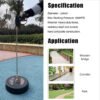


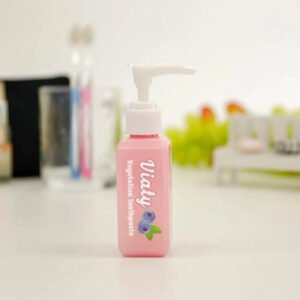
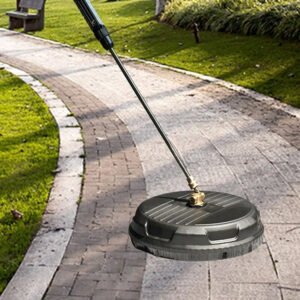
Reviews
There are no reviews yet.